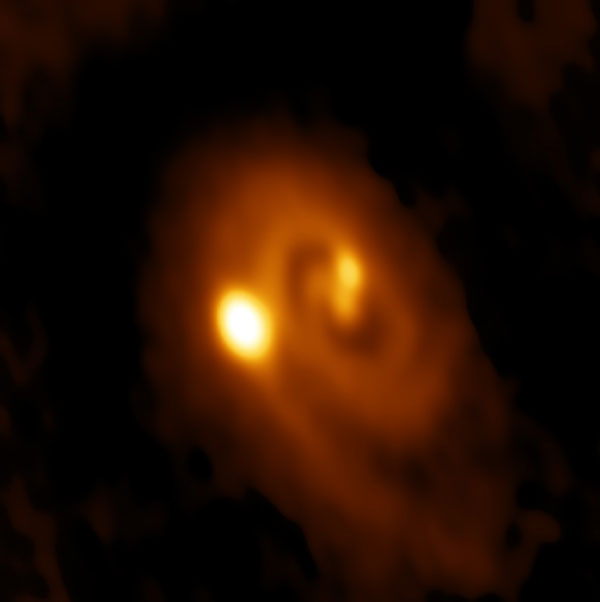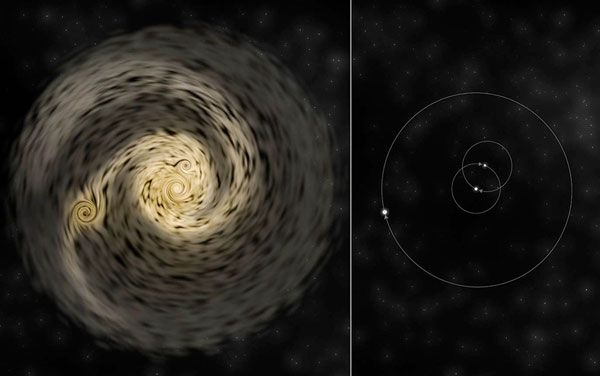Astronomy - ALMA Images Spiral Disk Around Baby Stars
Astronomers have imaged a third star embedded in the spiral disk around a pair of baby stars, the first direct evidence of a process of star formation known as disk fragmentation.

ALMA image of the L1448 IRS3B system, where two young stars orbit each other at the center and a third orbits out in the dusty disk connected to the central pair by a long spiral arm. The spiral structure indicates instability in the disk, which led to the formation of third baby star.
Bill Saxton / ALMA (ESO / NAOJ / NRAO), NRAO / AUI / NSF
Bill Saxton / ALMA (ESO / NAOJ / NRAO), NRAO / AUI / NSF
Our usual picture of star formation has stars condensing like droplets of rain out of their natal clouds of gas and dust. In fact, astronomers caught this process in action in the Perseus star-forming region a year ago.
But there’s more than one way to form a star.
Stars-to-be grow by gobbling gas in their vicinity. But if the disk that feeds a star grows big enough, the disk itself can wobble and collapse into a second star in a process known as disk fragmentation. Plenty of circumstantial evidence exists for this process, but astronomers have never actually seen it happen.
Until now. In a study published in the October 27th Nature, John Tobin (University of Oklahoma and Leiden University, The Netherlands) and colleagues have returned to Perseus with the Atacama Large Millimeter/submillimeter Array (ALMA) to study the triple protostar system L1448 IRS3B. The scientists penetrated the thick shroud surrounding three protostars, imaging the disk that feeds them.
And to their surprise, they discovered that the third baby star — once thought to be the central player of the system — is actually nestled in a long spiral arm extending from the parent binary. The image is the first direct observational evidence that stars form by disk fragmentation.
Caught in the Act
Astronomers already knew there were three stars in this system, but they had a totally different mental picture of what was going on. “For a long time (going back almost 20 years), we thought that the tertiary was the center of the system because it was the brightest,” Tobin says.
But ALMA’s images reveal that that’s not the case. The array’s radio “eyes” are two times sharper and ten times more sensitive than those used in previous studies. ALMA detects emission from the carbon monoxide molecule, which acts as a tracer for the molecular hydrogen reservoir that forms stars. (Molecular hydrogen by itself is nearly impossible to detect in star-forming clouds.) The motion of carbon monoxide revealed a disk centered, surprisingly, on the other two stars.
ALMA’s image isn’t even the neatest part of the result. “The strength of this study is the attention to detail in Tobin and colleagues’ analysis,” writes Adele Plunkett (ESO, Chile), author of an accompanying perspective piece. The team modeled how stable the disk is, gravitationally speaking, and showed that it’s in fact unstable right around where the tertiary star is forming. The result confirms that the disk is collapsing in on itself in this region to make the third star.

This image shows how the triple-star system develops: at left, a disk of material fragments into separate protostars, and at right, the stellar emerges after accumulating and/or dispelling the surrounding cloud. The central stars are 60 astronomical units apart (the diameter of Neptune's orbit), and the third star is 183 a.u. away from the central-most protostar.
Bill Saxton / NRAO / AUI / NSF
Amassing a Star
Astronomers can calculate the central duo’s mass by measuring how fast the disk rotates around them. Right now, the central two protostars have a combined mass equal to the Sun’s. They’ll still grow, but probably not too much more — most of the gas ALMA detects around them already effectively belongs to the stars.
The third protostar in the disk is more difficult to “weigh”: all we know at this point is that it’s in the process of gobbling down a chunk of gas worth 8.5% of the Sun’s mass. That explains why it’s the brightest object in the image: ALMA isn't seeing the star itself, but rather the glow of the cool dust and gas around it.
“I expect that the tertiary in the outer disk is likely to grow the most,” Tobin adds. Out there, the protostar has access to more raw materials than the primary pair in the central cavity. (The central two stars are mostly done growing at this point, having cleared out a cavity around them.) So while its mass may have the third protostar looking more like a brown dwarf at this point, Tobin predicts it will become a more massive, red dwarf star by the time all is said and done.
With this discovery, the question remains: how common is gravitational instability? How often do stars form in the shadow of their stellar siblings? “Fragmenting disks like the one observed by Tobin and colleagues are probably not rare,” Plunkett writes. “Rather, they are waiting to be studied in more detail using the powerful (sub-)millimeter-wavelength telescopes that are now available.”
No comments:
Post a Comment